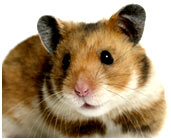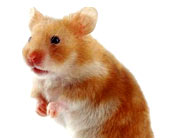A hamster is a small rodent with a stout body and a short tail. Find out some interesting & amazing information about hamsters here.
Facts About Hamster
Hamsters are small rodents that are popular as family pets in many countries. They are of crepuscular nature, i.e. most active during twilight. Normally, they have a stout body with strong legs and wide feet. They have cheek pouches on either side of their heads falling to their shoulders, which they use to store and carry food. Their tails are shorter, and they generally have small pointy ears. Amongst all the species, the Dwarf desert hamster is the smallest, while the largest is the Common hamster, measuring up to 34 cm long. They are geographically scattered in various regions, and are quite common in China, Korea, Siberia, Mongolia, India and Syria. There are 25 species of hamsters which are further categorized into six or seven groups. Hamsters are very common pets and often used as laboratory animals. They are easy to breed in captivity and are easy to keep as pets. They are solitary beings and generally do not need a pair (except during the mating season). Read on to get some interesting facts and amazing information on hamsters. 

Fast Facts
Kingdom: Animalia
Phylum: Chordata
Class: Mammalia
Order: Rodentia
Suborder: Myomorpha
Superfamily: Muroidea
Family: Cricitidae
Genera: Mesocricetus, Phodopus, Cricetus, Cricetulus, Allocricetulus, Cansumys and Tscherskia
Species: Cricetus cricetus,Mesocricetus auratus, Phodopus campbelli, Phodopus sungorus, Cricetulus griseus and Phodopus roborovskii
Natural Habitat: Mostly dry areas
Diet: Seeds, grasses, roots, fruits, vegetables, corn, pulses, insects, lizards, frogs and small mammals.
Teeth Color: Yellow or White
Gestation Period: 15-20 days
Life span: About 2 years
Interesting & Amazing information about Hamsters
- The native habitats of hamsters are the deserts of Asia.
- Hamsters borrow their name from the German word ‘Hamstern’, which means to hoard.
- Male hamsters are called ‘Bucks’ and females hamsters are called ‘Does’.
- Hamster burrows are up to 2 meters deep in the wilds.
- Hamster babies are known as puppies.
- The eyesight of hamsters reaches only up to six inches in front of them.
- Hamsters are color blind.
- Hamsters remember their relatives.
- Hamsters can be taught to react to names.
- Hamsters cannot be spayed or neutered.
- Hamsters are generally omnivorous.
- Hamsters are normally allergic to Cedar.
- The body fur of hamsters comes in a wide variety of colors, depending on the nature of the species.
- Regulation of temperature helps to determine the sex of dwarf hamster babies. Keeping the mother in warmer temperatures will lead to birth of more males, whereas keeping her in cooler temperatures will lead to the birth of more females.
- Normally, the breeding season of dwarf hamsters' is from April to September. However, if kept in lighting for eight hours or more a day, they will breed throughout the year.
- The Golden (Syrian) Hamsters Originated from the Middle Eastern Country Of Syria.
- The Djungarian Hamsters, also known as Cambells Dwarfs, are found on the steppes of Russia.
- The average life span of a hamster is between 2-4 years.
- Usually male hamsters live longer than the females.
- Of all the hamster species, the Roborovski Dwarf hamsters are the fastest.
- Hamsters were first discovered in Syria in 1830.
- The Syrian hamsters have four toes on their front feet and five on the back.
- These hamsters (Syrian) are available in more than 40 colors.
- All the Syrian Hamsters are descents of a wild female Syrian hamster that gave birth to a litter of 12 in 1930.
- Certain species of dwarf hamsters cab prolong the birth if their unborn litter if they are already tending a litter.
- If needed the dwarf female hamsters can produce a pheromone to signal the other females in the cage or breeding caves to stop mating!
- Syrian hamsters have been regarded endangered in the wild.
- Hamsters’ teeth grow throughout their lifetime. This is common to other rodents as well. In order to prevent their teeth from growing too long, they constantly chew toys/objects. Apart from keeping their teeth in shape, the chewing helps keep the teeth clean.
- Due to their poor sight, hamsters make use of their strong scent glands to recognize a particular object, territory, tunnel or even other hamsters. When they are in an unfamiliar location, they rub their bodies against the various objects to leave a trail which will help them get back to their homes.
- Though hamsters are sociable with humans, they aren’t quite comfortable with other hamsters. They are not much social with other animals as well.


See also
More from iloveindia.com
- Home Remedies | Ayurveda | Vastu | Yoga | Feng Shui | Tattoos | Fitness | Garden | Nutrition | Parenting | Bikes | Cars | Baby Care | Indian Weddings | Festivals | Party ideas | Horoscope 2015 | Pets | Finance | Figures of Speech | Hotels in India : Delhi | Hyderabad | Chennai | Mumbai | Kolkata | Bangalore | Ahmedabad | Jaipur
- Contact Us Careers Disclaimer Privacy Policy Advertise With Us Lifestyle Sitemap Copyright iloveindia.com. All Rights Reserved.




